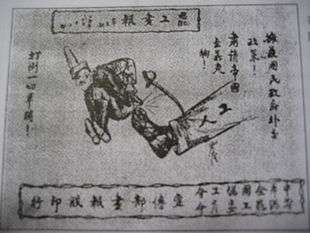Canton–Hong Kong strike
The Canton–Hong Kong strike (省港大罷工) was a strike and boycott that took place in British Hong Kong and Canton (now Guangzhou), Republic of China, from June 1925 to October 1926.[1][2] It started out as a response to the May 30 Movement shooting incidents in which Chinese anti-imperialist protesters were massacred by policemen, including Chinese and Sikh, under British command in Shanghai.

Incident
On May 30, 1925, Sikh police under British command opened fire on a crowd of Chinese demonstrators at the Shanghai International Settlement. At least 9 demonstrators were killed, and many others wounded.[1] Escalating the incident, on June 23, 1925, a heated demonstration in Shamian (then spelled Shameen) took place as part of the Shakee massacre.[2] Troops under foreign command killed more than 50 Chinese protesters and wounded almost 120 more.[1]
Strike
Guangdong called for a strike especially in Hong Kong where British imperialism was apparent. The Kuomintang leaders and Soviet advisors even considered attacking the International/Anglo-French Settlement in Shamian.[1] Anti-British pamphlets were passed around in Hong Kong. Rumours also spread that the Colonial government planned to poison the colony's water supplies.[1] Guangdong offered free train passage to Hong Kong. In the first week of protest, more than 50,000 Chinese left Hong Kong. Food prices soared. The colony was a ghost town by July. By the end of July, some 250,000 Chinese left for Guangdong.[1] The worst of the strike was over by 1926.[1]
Government and economy
The British government had to provide a trade loan of 3 million pounds to prevent the economy from collapsing. Hong Kong's top two colonial officials, Governor Sir Reginald Stubbs and Colonial Secretary Claud Severn were replaced in 1925 as a consequence of the crisis, under criticism from James Jamieson, British Consul General in Canton.[3] They, he said, were out of touch and out of date, unable to converse in Chinese and ignorant of republican China.[4]:98
An anti-British goods boycott continued for several more months.[1] The economy was paralysed and Hong Kong's total trade fell by 50%, shipping diminished by 40%, rents decreased by 60%.[2]
In literature
The Canton–Hong Kong strike plays a prominent part in André Malraux's first novel, The Conquerors (1928).
See also
- History of Colonial Hong Kong (1800s–1930s)
- History of the Republic of China
References
- Carroll, John Mark (2007). A concise history of Hong Kong. Rowman & Littlefield. p. 100. ISBN 978-0-7425-3422-3.
- Jens Bangsbo, Thomas Reilly, Mike Hughes. [1995] (1995). Science and Football III: Proceedings of the Third World Congress of Science and Football, Cardiff, Wales, 9–13 April 1995. Taylor & Francis publishing. ISBN 0-419-22160-3, ISBN 978-0-419-22160-9. p 42-43.
- Nield, Robert (2012). May Holdsworth; Christopher Munn (eds.). Dictionary of Hong Kong Biography. Hong Kong University Press. p. 390. ISBN 9789888083664.
- Kwan, Daniel Y K (1997). Marxist Intellectuals and the Chinese Labor Movement: A Study of Deng Zhongxia (1894-1933). University of Washington Press. ISBN 9780295976013.